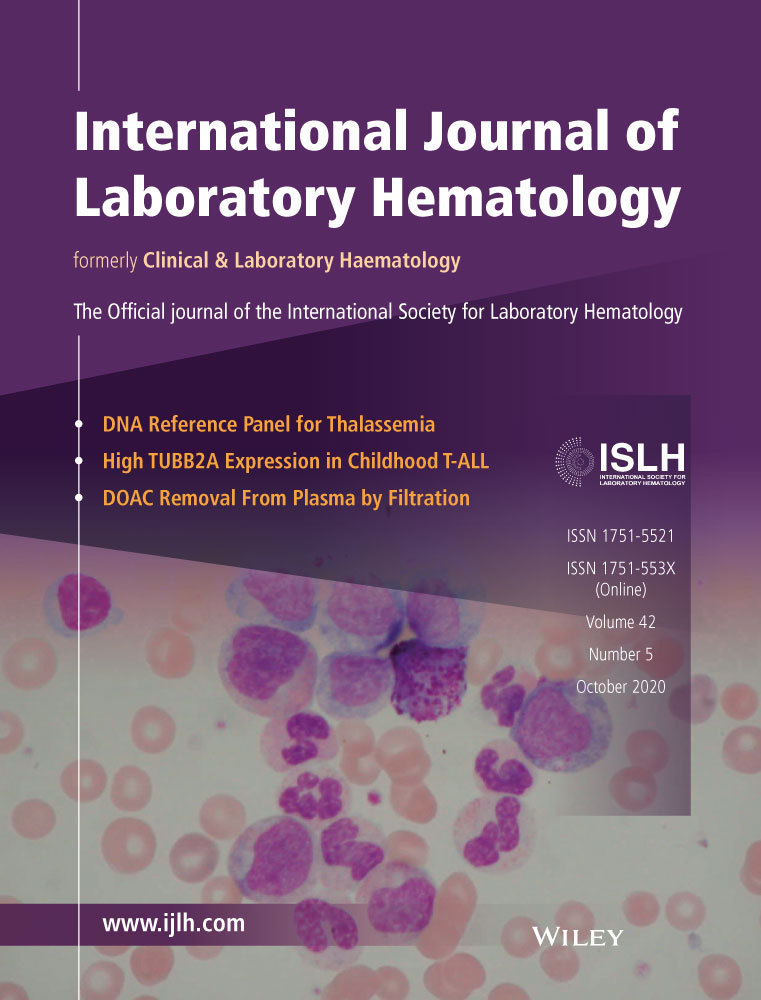Does age-adjusted D-dimer have a role in assessment of VTE recurrence rates? Comment
Corresponding Author
Will Thomas
Department of Haematology, Cambridge University Hospitals NHS Foundation Trust, Cambridge Biomedical Campus, Cambridge, UK
Correspondence
Will Thomas, Department of Haematology, Cambridge University Hospitals NHS Foundation Trust, Cambridge Biomedical Campus, Cambridge, UK.
Email: [email protected]
Search for more papers by this authorIrina Mindlina
Clinical School, University of Cambridge, Cambridge Biomedical Campus, Cambridge, UK
Search for more papers by this authorStephen MacDonald
Department of Haematology, Cambridge University Hospitals NHS Foundation Trust, Cambridge Biomedical Campus, Cambridge, UK
Search for more papers by this authorMartin Besser
Department of Haematology, Cambridge University Hospitals NHS Foundation Trust, Cambridge Biomedical Campus, Cambridge, UK
Search for more papers by this authorCorresponding Author
Will Thomas
Department of Haematology, Cambridge University Hospitals NHS Foundation Trust, Cambridge Biomedical Campus, Cambridge, UK
Correspondence
Will Thomas, Department of Haematology, Cambridge University Hospitals NHS Foundation Trust, Cambridge Biomedical Campus, Cambridge, UK.
Email: [email protected]
Search for more papers by this authorIrina Mindlina
Clinical School, University of Cambridge, Cambridge Biomedical Campus, Cambridge, UK
Search for more papers by this authorStephen MacDonald
Department of Haematology, Cambridge University Hospitals NHS Foundation Trust, Cambridge Biomedical Campus, Cambridge, UK
Search for more papers by this authorMartin Besser
Department of Haematology, Cambridge University Hospitals NHS Foundation Trust, Cambridge Biomedical Campus, Cambridge, UK
Search for more papers by this author
References
- 1Robertson C, Milne D, Watson H. Does age-adjusted D-Dimer have a role in assessment of VTE recurrence rates? J Lab Hematol. 2020: 1-3. [epub ahead of print].
- 2MacDonald S, Chengal R, Hanxhiu A, Symington E, Sheares K, Besser M, Thomas W. Utility of the DASH score after unprovoked venous thromboembolism; a single centre study. Br J Haematol. 2019; 185: 631-633.
- 3Mindlina I, MacDonald S, Chengal R, Hanxhiu A, Symington E, Sheares K, Besser M, Thomas W. Utility of the DASH score after unprovoked venous thromboembolism: single centre study and long-term patient outcomes. PB1635. (2019). Posters abstracts. Res Pract Thromb Haemost. 2019; 3: 1-891.
- 4Righini M, Van Es J, Den Exter PL, et al. Age-adjusted d-dimer cutoff levels to rule out pulmonary embolism: the ADJUST-PE study. JAMA. 2014; 311(11): 1117-1124.
- 5Kearon C, Iorio A, Palareti G. Risk of recurrent venous thromboembolism after stopping treatment in cohort studies: recommendation for acceptable rates and standardized reporting. J Thromb Haemost. 2010; 8: 2313-2315.
- 6Rodger MA, Le Gal G, Anderson DR, et al. Validating the HERDOO2 rule to guide treatment duration for women with unprovoked venous thrombosis: multinational prospective cohort management study. BMJ. 2017; 356: j1065.
- 7Tosetto A, Iorio A, Marcucci M, et al. Predicting disease recurrence in patients with previous unprovoked venous thromboembolism: a proposed prediction score (DASH). J Thromb Haemost. 2012; 10(6): 1019-1025.
- 8Tosetto A, Testa S, Martinelli I, et al. External validation of the DASH prediction rule: a retrospective cohort study. J Thromb Haemost. 2017; 15: 1963-1970.
- 9Kearon C, Spencer FA, O'Keeffe D, et al. D-dimer testing to select patients with a first unprovoked venous thromboembolism who can stop anticoagulant therapy: a cohort study. Ann Intern Med. 2015; 162: 27-34.
- 10Rodger MA, Le Gal G, Langlois NJ, et al. "HERDOO2" clinical decision rule to guide duration of anticoagulation in women with unprovoked venous thromboembolism. Can I use any d-Dimer? Thromb Res. 2018; 169: 82-86.




